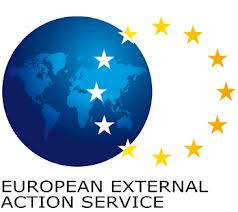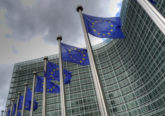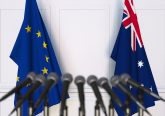 With the Lisbon Treaty, the member states of the European Union (EU) established a European External Action Service (EEAS), otherwise known as the ‘European foreign service’, consisting of several thousand officials drawn from the EU institutions and national diplomatic offices. The EEAS has existed since January 2011 and falls under the authority of the EU High Representative Lady Ashton. In addition to the Brussels headquarters, there are some 140 EU delegations (’embassies’) in other countries.
With the Lisbon Treaty, the member states of the European Union (EU) established a European External Action Service (EEAS), otherwise known as the ‘European foreign service’, consisting of several thousand officials drawn from the EU institutions and national diplomatic offices. The EEAS has existed since January 2011 and falls under the authority of the EU High Representative Lady Ashton. In addition to the Brussels headquarters, there are some 140 EU delegations (’embassies’) in other countries.
This spring, there will be a formal review. The mid-2013 review of the EEAS, as it is called, presents an opportunity to improve the current structure. Catherine Ashton should use the momentum of this review to make the EEAS a more effective international actor. The EEAS will be an important part of her legacy after she resigns as High Representative next year.
I have five recommendations.
1. The EEAS and the national diplomatic career
The effectiveness of the EEAS depends on the quality of its staff. A large proportion of the staff working in Brussels and in the EU delegations consists of national diplomats on a temporary 3-4 year contract. To ensure that the EEAS attracts the best and the brightest, it is very important that national diplomats consider an EEAS posting a good career step. This is not automatically the case. By going on a secondment for a couple of years, diplomats lose valuable contacts and are out of the picture when it comes to promotions.
As a first step, the member states should therefore submit, as part of the EEAS review, a report on their national policies for the selection and reintegration of EEAS diplomats. This would force all the member states to at least think about the issue, potentially formulate policy, and to exchange best practices. As a second step, the member states should make a posting to the EEAS an integral part of a national diplomatic career. A secondment can, for example, become a formal prerequisite for national ambassadorial posts.
2. Less bureaucracy, more action
Any foreign service needs to be able to react quickly to unfolding international events. This means short reporting lines as well as proactive desk officers with real responsibility. When the EEAS was established, however, it used the bureaucratic model of the European Commission. That offered too many different layers, too much middle management and complicated accountability structures. On top of this, member states engage in horse-trading when it comes to top postings.
One idea would be to abolish the Corporate Board. This body sits at the top of the EEAS and essentially duplicates the work of the High Representative’s cabinet. It also introduces unnecessary politics into the EEAS: it currently consists of French, Irish, German and Polish nationals (originating respectively from the member states, the Commission, the Council and the Parliament), who also have their own mini-cabinets. The composition is thus clearly a political compromise aimed at giving everyone some control over the EEAS. The Corporate Board can be replaced by including two or three additional advisors in the High Representative cabinet. The various (managing) directors in the EEAS can then directly report to the cabinet instead of to the Corporate Board.
3. Nomination procedure of the High Representative
The High Representative is also part of the College of Commissioners as one of the Vice-Presidents of the European Commission. This means that his/her tenure (five years) follows the same cycle as that of the other Commissioners. The result is that various high-level EU positions need to be filled at exactly the same moment (i.e. Commission President, European Council President, Parliament President, High Representative). This creates an incentive for horse-trading between the member states. People might thus be nominated as High Representative on qualities different than merit, problematic because it is a post that needs very specific qualifications.
This is a problem that is difficult to solve. Changing the timing of the nomination will be impossible given the current Treaty rules. And the question is whether timing will really make a difference. One way out is to agree on a rather specific profile in advance (for example: keeping diplomatic and military duties at ministerial level). More ambitiously, there could be an ‘open competition’ in which candidates formally have to apply for the job to the European Council. While full de-politicization is unlikely, the most important point is to de-couple the selection process from the other top jobs.
4. Integration of Crisis Management in the EEAS
The EU prides itself on the so-called comprehensive approach to global affairs. The idea is that the EU is in a unique position to combine economic, political, developmental and military tools when addressing international crises. While one should not overestimate such added value, it is a useful platform on which the EU can build its foreign policy.
The trouble is, of course, that there is nothing comprehensive about the EEAS. The various crisis management directorates have been kept completely separate from the rest of the machinery, even located in a different building. The EEAS review should look into possibilities for synergies. Regular coordination meetings between the actors are simply not enough. When people are put in boxes, there will inevitably be an ‘us-them feeling’ and at worst everyone might be competing for attention and resources.
5. Towards Consular Services
Perhaps the most tangible evidence of the EU foreign service is to be found in countries outside the Union where EU delegations increasingly play a vital role. They coordinate the work of national embassies; they represent the European Union and its policies; and they engage in political reporting. This gives them the potential to complement the work of (smaller) national diplomatic services.
Alas the one thing that EU delegations do not do currently is offer real consular services. Given that they have such a wide presence, it would be extremely beneficial if they start issuing passports, visas and provide other forms of consular support. These are, of course, sensitive issues. Yet the EU delegation could work on an opt-in basis. For instance, the Hungarian government could allow the EU delegation in Tanzania to collect relevant passport forms for Hungarian citizens and send these to Budapest for processing. The extensive network of EU delegations could thus be much better used for the benefits of EU citizens.
Moving forward
We should recognise that the EEAS is a new structure and still requires work. These five recommendations will, I hope, help the EEAS to become a better, more flexible, integrated and outward looking diplomatic service. Not all of this can be implemented overnight. It is therefore important that member states establish a follow-up process by asking the EEAS to write an annual report on reform implementation beyond the 2014 changes in the mandate that are currently foreseen. Improving the EEAS should become a continuous process.







3 Comments
Interesting and important thoughts!
1) I agree – at the moment, some EUMS appear to have a strategy on EEAS secondments whereas others look at it simply on a case-by-case basis.
2) Obviously, less bureaucracy is always a good idea where bureaucracy is an impediment. However, I’m not sure I agree with your proposed abolition of the CB. After all, most diplomatic services I know about have a dual structure with a Foreign Minister plus Cabinet (=HRVP Ashton) on the one hand, and a senior diplomat (the UK calls it Permanent Under-Secretary, Germany calls it State Secretary, in France it’s the Secrétaire général etc.) on the other hand, who usually have deputies as well. In the EEAS, this latter role is played by Vimont / O’Sullivan plus two deputies. That doesn’t seem *that* bureaucratic in comparison yet, e.g. when compared to the US State Dept. I suppose it should also be the case that those four positions are seen as more permanent and less political than the HRVP one, i.e. wouldn’t change necessarily when a new HRVP arrives, though that remians to be seen.
3) I agree that it would be nice if the position would be less political and more merit-based (but again, it’s essentially a Foreign Minister role, and thus eminently political). But I don’t see why a de-coupling in terms of time of appointment would lead to less horse-trading? “Hey, you got the Commission President post 2 years ago, now it’s our turn to get the HRVP” works just as well…
4) Yes. I read somewhere recently that the EEAS is the first combination of a foreign and a defense ministry, which obviously creates problems. Military officers and diplomats tend to have different working cultures. Stronger civil-military cooperation is already an aim of the European Security Strategy, but it would be nice if both the civil and the military CSDP structures would be more closely integrated with geographic and multilateral MDs.
5) I like this idea. Embassies of Schengen countries already co-operate bilaterally so that e.g. the German embassy in Mongolia can also act for other European countries. The possibility of extending this scheme to EU DELs should be considered, though it’s worth bearing in mind that this would require recruiting consular service officials and building up consular knowledge in the EEAS — the EU officials found in EU DELs in developing countries are today mostly from DEVCO or TRADE and specialists in project management, trade relations etc. and not experts on Schengen visa…
6) Something which has been suggested recently is the possibility of EU military attachés in selected EU Delegations – do people think this is a) politically feasible and b) useful for any purpose? (EDA cooperation projects?)